How to deal with fusarium cucumber: life-saving advice from gardeners and proven means
It's a shame when a cucumber bush grown with love and care suddenly withers. Gardeners in such a situation immediately ask themselves: what did I do wrong? There are many possible reasons for cucumber wilting. One of them is fusarium.
What is fusarium wilting, what are the symptoms and causes of fusarium cucumber, how to cure and prevent it - read this article.
The content of the article
What is cucumber fusarium
Fusarium, or fusarium wilting of cucumbers, is an infection caused by the fungus Fusarium oxysporum or Verticillium spp. Its spores spread through the soil, carried by wind and water, infecting plants and causing them to wilt.
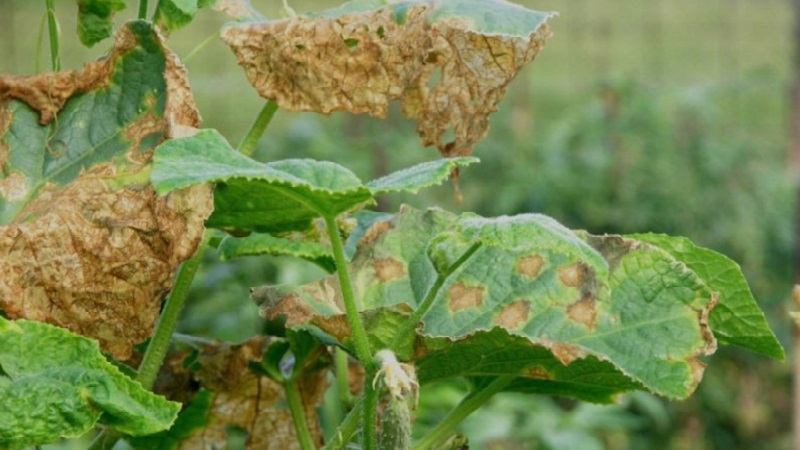
Fusarium can affect not only cucumbers, but also other crops growing nearby. The disease is characterized by a rapid spread, therefore it is important to notice in time the bacterial wilting in the greenhouse and open field in plants and take immediate action.
The reasons
Fusarium can appear on cucumbers for various reasons.:
- contaminated soil;
- non-compliance with crop rotation;
- infected seeds;
- watering plants with water containing fungal spores.
Favorable conditions for the spread of the fungus:
- acidic soil;
- microtrauma on the roots and root hairs;
- lack of nutrients in the soil, non-compliance with the feeding schedule;
- sharp jumps in temperature and humidity of air and soil;
- pest attacks;
- lack of heating in the greenhouse;
- air temperature from 18 ° С to 25 ° С.
About other diseases of cucumbers:
Causes and treatment of black plaque on the leaves
Causes and treatment of cucumber anthracnose
Prevention and effective treatment of peronosporosis in cucumbers
Symptoms
The peculiarity of the disease is that its main symptoms appear only during the flowering period. cucumber. And already during fruiting, the disease completely destroys the plant. The first sign of the disease in young plants is the appearance of root rot: the lower part of the stem darkens and gradually becomes thinner.
The main symptoms of fusarium cucumber:
- leaves gradually wither (from bottom to top);
- the green part of the bush turns pale, yellow spots appear;
- a pink bloom appears on the stem - conidia of the fungus;
- the stem darkens, cracks, traces of rot become noticeable;
- ovaries turn yellow and die off;
- fruits do not develop;
- as the disease develops, all parts of the plant gradually wither, and as a result, it dies.
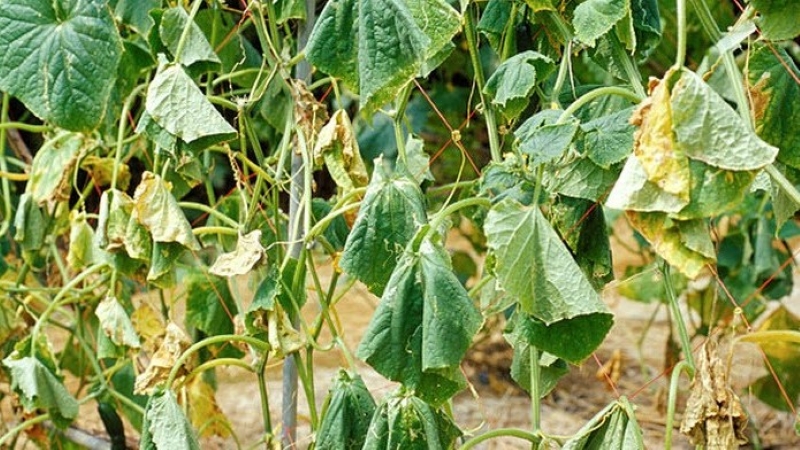
Measures to protect against fusarium and wilting
Since the disease does not manifest itself immediately, it is extremely difficult to fight it.... Basically, drugs help at an early stage in the development of the disease.
There are three options for protecting cucumbers from fusarium:
- chemical agents;
- biological products;
- folk methods.
Important! If you find Fusarium, immediately remove the diseased bush from the garden and burn it to prevent the spread of infection.
Chemicals
Unfortunately, fungicide treatment of cucumbers for fusarium is rarely effective, especially at a late stage of the disease.
One of the suitable drugs is "Fundazol"... Firstly, for disinfection, seeds are treated with it before planting. Secondly, in the early stages of fusarium wilting, a solution of "Fundazole" is watered at the roots and the aerial part of the plant is sprayed. The action of the drug lasts 2-3 weeks.
A 0.2% solution will help to cope with foci of infection on cucumbers fungicide "Topsin-M" or 0.15% solution of "Previkur Energy". Also, at an early stage of fusarium, drugs such as "Maxim", "Gymnast", "Quadris" and "Acrobat MC" are used. Treatment of seeds and seedlings with "Humisol" will help to increase resistance to fusarium wilt.
Important! After processing cucumbers with chemicals, the fruits from the bushes can be collected no earlier than a month later. Carefully follow the instructions for the drugs, take precautions.
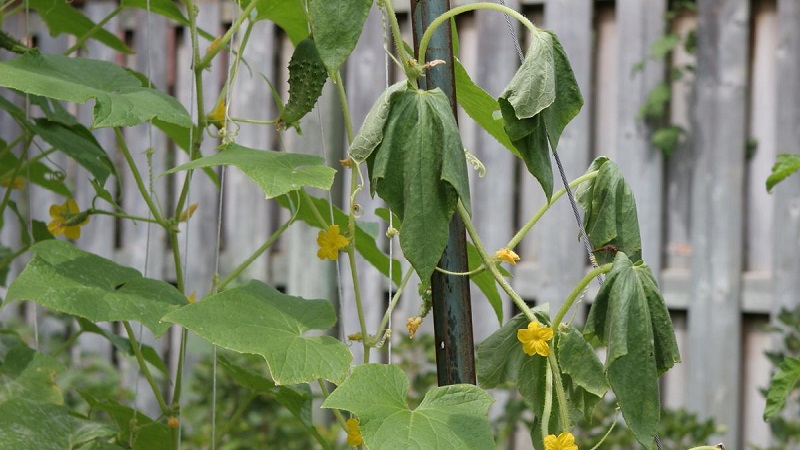
Biologicals
The most popular biological product among gardeners to combat fusarium on cucumbers - "Trichodermin". For prevention, it is introduced into the soil a few days before planting the seedlings, and if infected, the plants and soil are sprayed with a suspension according to the instructions for the preparation.
Also effective from fusarium such biological products as "Planriz", "Tikhophyte", "Baktofit". But they are used exclusively for prevention.
A modern biological agent that can be used already with the development of fusarium wilting, - "Fitosporin-M"... It stops the spread of fungal infection. Available in powder, paste and liquid form. Plants are processed according to the instructions for the preparation.
Attention!The instructions for the preparation indicate how long it is necessary to wait between the treatment of the bush and the harvest.
Traditional methods
When it comes to plants whose fruits are eaten, gardeners are reluctant to resort to chemistry. They are interested in whether there are any natural ways to get rid of fusarium on cucumbers. To the aid of summer residents in the fight against fusarium wilting comes treatment with folk remedies.
The most popular drug is milk whey solution... 1 liter of ordinary whey is diluted in 2.5 liters of water and mixed thoroughly. Cucumbers are sprayed with such a solution both for treatment and for the prevention of fusarium wilting.
Another recipe is iodine with milk... In 1 liter of raw milk add 30 drops of a pharmaceutical solution of iodine and 20 g of crushed laundry soap. Mix thoroughly and spray every 10 days during the growing season of the plant.
Garlic infusion prepare according to the following instructions: 50 g of garlic is chopped and diluted in 1 liter of pure water. Insist for a day, after which water is added to 9 liters. Cucumber bushes can be sprayed with such an infusion once, or you can repeat the procedure, if desired.
Another infusion from fusarium - infusion of wood ash. In 2 liters of boiling water add 1 glass of wood ash and 10 g of laundry soap. Insist 48 hours and spray the cucumbers twice - at weekly intervals.
Yeast treatment will help in the fight and prevention of fusarium... 100-200 g of fresh baker's yeast is diluted in 10 liters of water and poured into the soil.
Is it possible to fight in the active phase of development
Unfortunately, the effectiveness of these methods in the fight against actively developing fusarium is not high.... Since the disease is almost invisible at an early stage of development, it is extremely difficult to take timely measures.
When the fungus became noticeable and no longer amenable to treatment, the most effective way is to save healthy plants by removing a diseased bush from a greenhouse or garden bed, and then burn it and never leave it in compost.
For these reasons gardeners prefer to do everything possible to prevent the appearance fungus in the ground.
Attention! The main advice: follow preventive measures so that your plants do not overtake fusarium wilting.
Preventive measures
Focus on issues related to cucumber fusarium, gardeners pay precisely to prevention. The disease is transmitted mainly through soil and infected seeds. Therefore, special attention should be paid to them in the prevention of fusarium wilting of cucumbers.
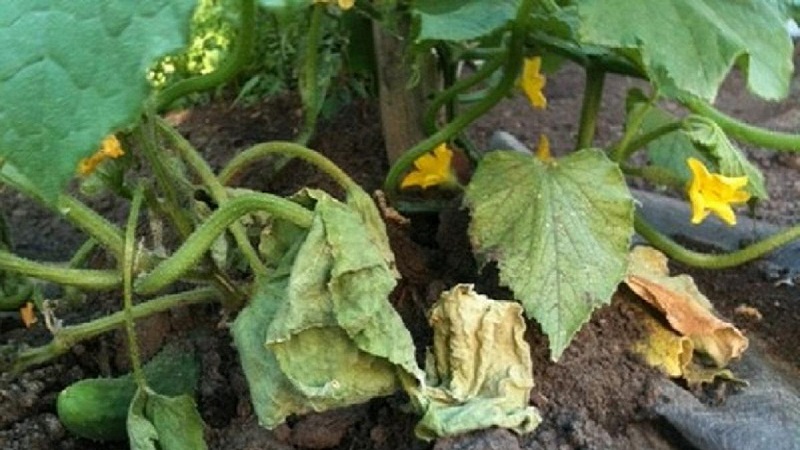
Effective prevention measures:
- soil disinfection - boiling water treatment, removal of the top layer of soil and replacement with a new one, disinfectants;
- careful selection of seeds - choose healthy, purchased from a trusted manufacturer or harvested from high-quality, even fruits;
- seed treatment with antifungal drugs - soaking in fungicides;
- correct crop rotation - cucumbers can be returned to their original place only after 4 years;
- systematic inspection of the plant for symptoms of the disease - it is important not to miss the very first signs;
- timely harvesting - every 2-3 days, so overripe fruits do not weigh down the whips and do not deplete the bush;
- timely feeding - planting is covered with mullein, during flowering - with chicken droppings, and during fruiting - with ash; during the growth of the bush, fertilize it with nitrogen, during flowering and fruiting - with potassium and phosphorus, completely excluding nitrogen from the feeding;
- spraying and watering plants with fungicides;
- sterilization of tools and clothing - fungus spores can remain and overwinter on clothing or garden tools;
- observance of the temperature regime - at temperatures above 35 ° C, cucumbers wilt and weaken (the ideal air temperature for a plant is 20-25 ° C);
- correct watering - cucumbers should be watered with warm rainwater 1-2 times a day, depending on the air temperature; at temperatures below 15 ° C, stop watering;
- pest control to avoid reducing plant immunity;
- removing diseased plants and burning them so that the fungus does not have time to move to neighboring healthy bushes;
- selection of cucumber varieties resistant to fusarium.
And a little about pests of culture:
Resistant varieties
Agronomists have long learned to breed plants that are resistant to various diseases.... Therefore, there are a considerable number of cucumber varieties that are not afraid of fusarium wilting. These are mainly hybrids labeled F1. If you doubt that you can protect the planting from fusarium, it is better to choose one of them.
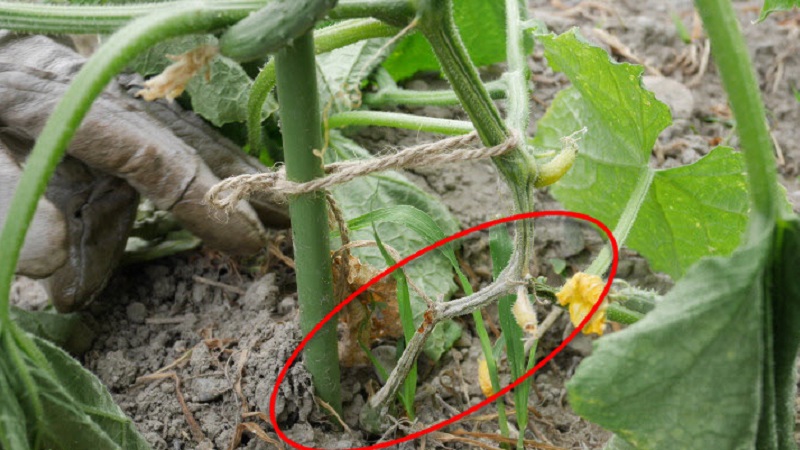
Most popular varieties:
- Noble - a mid-early hybrid requiring insect pollination, resistant to fusarium, anthracnose, bacteriosis, cladosporosis, ascochitosis and viral infections.
- Vocal is a high-yielding hybrid, resistant to fungal infections and adverse conditions: high humidity, temperature changes, lack of sunlight.
- Obskiy is a hybrid with tasty and juicy fruits, resistant to fusarium, peronosporosis, bacteriosis and temperature changes.
- Ideal and Vityaz are mid-early parthenocarpic hybrids.
- Bunny, Zhukovsky, Hector and Alex are early maturing parthenocarpic hybrids.
- Sir, Dolomite and Christina are early maturing bee-pollinated hybrids.
In addition to these varieties, cucumbers show resistance to fusarium Ryabinushka, Dunyasha and Caprice. The manufacturer indicates the characteristic features of the variety in the description on the package with the seeds, where you can also find information about the diseases to which they are resistant.
However prevention should be carried out even when growing disease-resistant varieties... Be extremely attentive to cucumber bushes and other plantings in your greenhouse or on the site - and you will get a healthy, tasty and high-quality harvest.
Conclusion
Fusarium is an insidious disease that does not manifest itself at an early stage of development. When signs of damage become visible, it is almost impossible to cope with the disease. In such a situation, it remains only to remove and burn the diseased bush - so you can save healthy plants from wilting.
Since fusarium is practically not amenable to treatment, do not neglect preventive measures. Choose disease resistant varieties. Disinfect soil and tools, treat seeds and seedlings, use fungicides, and properly care for cucumber bushes.